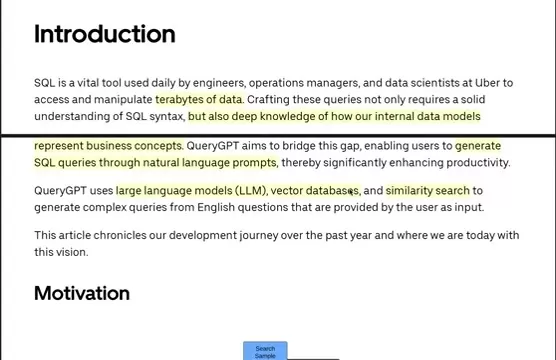Uber's QueryGPT: Revolutionizing SQL Query Creation with AI
In the fast-paced, data-centric landscape of modern business, efficiently querying and managing data is vital for organizations of all sizes. SQL, the cornerstone language for database interaction, often demands specialized expertise and time. Uber's QueryGPT transforms this process by harnessing generative AI to convert natural language into SQL queries, simplifying data access and enhancing productivity for engineers, operations managers, and data scientists. Explore how QueryGPT is reshaping data interaction and the critical insights gained from its development.
Key Points
QueryGPT, developed by Uber, uses generative AI to transform natural language into SQL queries.
The tool aims to simplify the complexity of SQL syntax, making data access more efficient and productive.
It leverages large language models (LLMs), vector databases, and similarity search to craft precise SQL queries.
Insights from QueryGPT’s development highlight the significance of high-quality data, effective model design, and thorough evaluation strategies.
At Uber, SQL is an essential daily tool for engineers, operations managers, and data scientists to handle vast datasets.
Understanding QueryGPT: From Natural Language to SQL
What is QueryGPT?
QueryGPT, an innovative tool from Uber, employs generative AI to convert natural language questions into SQL queries, streamlining data querying and manipulation for engineers, operations managers, and data scientists.

By bridging natural language and SQL, QueryGPT enables users to create complex queries effortlessly, boosting productivity. It integrates large language models (LLMs), vector databases, and similarity search. LLMs interpret user queries, vector databases provide relevant database context, and similarity searches refine the resulting SQL query for accuracy.
QueryGPT’s core mission is to make data accessible to a broader audience within an organization. Users without deep SQL expertise can now extract insights from databases by asking questions in plain English, fostering data-driven decisions across departments.
The development of QueryGPT reflects a broader industry shift toward AI-driven data management solutions. As organizations grapple with massive datasets, tools like QueryGPT unlock hidden insights, making data more approachable and actionable.
The Motivation Behind QueryGPT
QueryGPT was born from the need to overcome the time-intensive and complex process of manually crafting SQL queries.

SQL demands a strong grasp of syntax and database schemas, which can be a barrier for many. QueryGPT seeks to democratize data access at Uber, enabling users with minimal SQL knowledge to retrieve and analyze data efficiently.
Traditional SQL query creation often involves:
- Navigating database schemas: Understanding intricate tables and relationships can be challenging.
- Mastering SQL syntax: Mistakes are frequent, leading to time-consuming debugging.
- Optimizing query performance: Efficiency requires advanced expertise.
QueryGPT simplifies this by offering an intuitive interface where users input natural language questions. Its AI engine then generates optimized SQL queries ready for execution, freeing up time for data scientists and engineers to focus on analysis and strategic tasks.
Ultimately, QueryGPT accelerates data insights, empowering users to make informed decisions and fostering a data-driven culture across the organization.
Deep Dive into QueryGPT's Architecture
Components of the QueryGPT System
QueryGPT’s architecture combines advanced AI technologies, including large language models (LLMs), vector databases, and similarity search algorithms, to accurately interpret natural language queries and produce precise SQL commands.
Large Language Models (LLMs): The backbone of QueryGPT, LLMs are trained on vast text and code datasets, enabling them to grasp human language nuances and SQL syntax. When a user submits a query, the LLM identifies key entities and relationships, creating an initial SQL query structure.
Vector Databases: To ensure contextual accuracy, QueryGPT uses vector databases to store embeddings of database schemas, including table and column names and their relationships. These embeddings capture semantic meanings, helping the system pinpoint relevant schema elements based on the query.
Similarity Search: This component refines the SQL query by comparing the LLM’s initial structure to a database of successful queries, incorporating elements from similar past queries to enhance accuracy and efficiency.
The synergy of these components drives QueryGPT’s effectiveness. The LLM interprets the query, the vector database provides schema context, and similarity search refines the output, ensuring accurate and optimized SQL queries.
The Benefits of This Architecture
QueryGPT’s architecture delivers several advantages:
- Enhanced Accuracy: The integration of LLMs, vector databases, and similarity search ensures precise SQL query generation.
- Greater Efficiency: The system quickly identifies relevant schema elements, reducing query formulation time.
- Scalability: Designed for enterprise use, it handles large, complex databases effectively.
- Cost Savings: Automating query generation minimizes manual coding and debugging efforts.
By leveraging cutting-edge AI, QueryGPT empowers users to extract insights without extensive SQL knowledge, driving data-driven decision-making across organizations.
How to Use QueryGPT
Step-by-Step Guide to Generating SQL Queries
Using QueryGPT is intuitive. Here’s how to generate SQL queries from natural language:
- Access QueryGPT: Open the QueryGPT app or web interface.
- Input Your Question: Enter a natural language question, such as “What’s the total number of rides per day?”
- Choose the Database: Select the target database from available options.
- Review the SQL: QueryGPT generates an SQL query. Check it for accuracy.
- Run the Query: Click “Execute” to process the query against the database.
- Analyze Results: View the results in a table format for insights.
Tips for Success:
- Be Precise: Clear, specific questions yield better queries.
- Use Plain Language: Avoid jargon or vague terms.
- Provide Context: Add details if needed to clarify intent.
- Verify the SQL: Always review the generated query before execution.
With these steps, QueryGPT enables anyone to access and analyze data without writing SQL manually, ensuring clarity and accuracy.
QueryGPT Pricing
Understanding the Cost Structure
As an internal Uber tool, QueryGPT is not available as a standalone product, so no direct pricing details exist.
Businesses seeking similar natural language-to-SQL solutions can explore commercial options with pricing models like:
- Subscription Plans: Pay a recurring fee for access.
- Usage-Based Pricing: Costs depend on query volume or data processed.
- Enterprise Licensing: Tailored agreements for large organizations.
When choosing a solution, evaluate query accuracy, platform scalability, support quality, and cost-effectiveness to ensure efficient data access.
Advantages and Disadvantages of QueryGPT
Pros
Simplifies data access for non-technical users
Boosts productivity for data scientists and engineers
Speeds up insight generation
Lowers development costs
Promotes data-driven decisions
Cons
Possible query inaccuracies
Reliance on high-quality data
Limited support for advanced SQL features
Data security concerns
Core Features of QueryGPT
Key Functionalities and Capabilities
QueryGPT offers robust features to streamline SQL query generation and improve data accessibility.
- Natural Language Processing: Advanced NLP interprets user questions for seamless query creation.
- SQL Query Generation: Automatically produces SQL queries from natural language inputs.
- Schema Awareness: Analyzes database schemas to ensure accurate query generation.
- Query Optimization: Enhances query performance for efficient data retrieval.
- Intuitive Interface: Simplifies interaction for all users.
- Data Visualization Integration: Connects with visualization tools for enhanced analysis.
These features make QueryGPT a powerful tool for simplifying data access, reducing SQL expertise requirements, and accelerating insights.
Use Cases for QueryGPT
Real-World Applications of Natural Language to SQL
QueryGPT supports diverse applications across industries and roles.
- Data Analysis: Enables data scientists to extract and analyze data for research.
- Business Intelligence: Helps analysts create reports and dashboards to track KPIs.
- Customer Support: Allows representatives to quickly access customer data.
- Operations Management: Supports monitoring and issue detection.
- Self-Service Analytics: Empowers non-technical users to analyze data independently.
Specific Examples:
- Retail: Analyze sales to identify top products.
- Finance: Detect fraudulent transactions.
- Healthcare: Track patient outcomes to enhance care.
QueryGPT fosters a data-driven culture, improving decision-making and efficiency across organizations.
Frequently Asked Questions (FAQ)
What types of databases does QueryGPT support?
QueryGPT supports relational databases like MySQL, PostgreSQL, SQL Server, and Oracle, though support varies by configuration.
How accurate is QueryGPT in generating SQL queries?
Accuracy depends on query complexity, input clarity, and data quality. Reviewing generated queries is recommended for best results.
Can I customize the generated SQL queries?
Yes, users can modify query structures, filters, and parameters to meet specific needs.
Is QueryGPT secure?
QueryGPT prioritizes security with access controls, encryption, and audit logging to protect sensitive data.
Does QueryGPT require special hardware or software?
It runs on standard infrastructure, with requirements varying by database size and user volume.
Related Questions
How does QueryGPT compare to other natural language to SQL solutions?
QueryGPT stands out with its advanced architecture, accuracy, and seamless integration. Here’s a comparison:
Feature | QueryGPT | Alternative Solution A | Alternative Solution B
Core Architecture | LLMs, Vector Databases, Similarity Search | Rule-Based System | Statistical Model
Accuracy | High | Moderate | Moderate
Efficiency | Very Efficient | Less Efficient | Less Efficient
Scalability | Highly Scalable | Limited Scalability | Limited Scalability
Customization | Extensive Options | Limited Options | Limited Options
Security | Robust Measures | Basic Features | Basic Features
Integration | Seamless with Existing Infrastructure | Significant Effort Needed | Significant Effort Needed
Pricing | Internal Tool - No Direct Cost | Subscription-Based | Usage-Based
Why QueryGPT Excels:
Architecture: Its blend of LLMs, vector databases, and similarity search offers superior query understanding compared to rule-based or statistical systems.
Accuracy: The multi-layered approach ensures precise query generation.
Efficiency: Quick schema identification and optimized queries save time.
Scalability: Handles large databases effectively for enterprise use.
Customization: Offers extensive query fine-tuning options.
In summary, QueryGPT’s innovative design and focus on accuracy and scalability make it a leading solution for data-driven decision-making.
Related article
 Google Commits to EU’s AI Code of Practice Amid Industry Debate
Google has pledged to adopt the European Union’s voluntary AI code of practice, a framework designed to assist AI developers in aligning with the EU’s AI Act by implementing compliant processes and sy
Google Commits to EU’s AI Code of Practice Amid Industry Debate
Google has pledged to adopt the European Union’s voluntary AI code of practice, a framework designed to assist AI developers in aligning with the EU’s AI Act by implementing compliant processes and sy
 Selecting the Best AI Coding Tool for Your Project
The software development landscape is transforming rapidly, with Artificial Intelligence (AI) becoming a key driver. AI coding tools enable developers to write code faster, more accurately, and with g
Selecting the Best AI Coding Tool for Your Project
The software development landscape is transforming rapidly, with Artificial Intelligence (AI) becoming a key driver. AI coding tools enable developers to write code faster, more accurately, and with g
 AI-Powered Podcast Tools for Streamlined Content Creation
Producing and refining a podcast can be both demanding and fulfilling. Many podcasters face challenges with time-intensive tasks like removing filler words, crafting compelling show notes, and promoti
Comments (0)
0/200
AI-Powered Podcast Tools for Streamlined Content Creation
Producing and refining a podcast can be both demanding and fulfilling. Many podcasters face challenges with time-intensive tasks like removing filler words, crafting compelling show notes, and promoti
Comments (0)
0/200
In the fast-paced, data-centric landscape of modern business, efficiently querying and managing data is vital for organizations of all sizes. SQL, the cornerstone language for database interaction, often demands specialized expertise and time. Uber's QueryGPT transforms this process by harnessing generative AI to convert natural language into SQL queries, simplifying data access and enhancing productivity for engineers, operations managers, and data scientists. Explore how QueryGPT is reshaping data interaction and the critical insights gained from its development.
Key Points
QueryGPT, developed by Uber, uses generative AI to transform natural language into SQL queries.
The tool aims to simplify the complexity of SQL syntax, making data access more efficient and productive.
It leverages large language models (LLMs), vector databases, and similarity search to craft precise SQL queries.
Insights from QueryGPT’s development highlight the significance of high-quality data, effective model design, and thorough evaluation strategies.
At Uber, SQL is an essential daily tool for engineers, operations managers, and data scientists to handle vast datasets.
Understanding QueryGPT: From Natural Language to SQL
What is QueryGPT?
QueryGPT, an innovative tool from Uber, employs generative AI to convert natural language questions into SQL queries, streamlining data querying and manipulation for engineers, operations managers, and data scientists.

By bridging natural language and SQL, QueryGPT enables users to create complex queries effortlessly, boosting productivity. It integrates large language models (LLMs), vector databases, and similarity search. LLMs interpret user queries, vector databases provide relevant database context, and similarity searches refine the resulting SQL query for accuracy.
QueryGPT’s core mission is to make data accessible to a broader audience within an organization. Users without deep SQL expertise can now extract insights from databases by asking questions in plain English, fostering data-driven decisions across departments.
The development of QueryGPT reflects a broader industry shift toward AI-driven data management solutions. As organizations grapple with massive datasets, tools like QueryGPT unlock hidden insights, making data more approachable and actionable.
The Motivation Behind QueryGPT
QueryGPT was born from the need to overcome the time-intensive and complex process of manually crafting SQL queries.

SQL demands a strong grasp of syntax and database schemas, which can be a barrier for many. QueryGPT seeks to democratize data access at Uber, enabling users with minimal SQL knowledge to retrieve and analyze data efficiently.
Traditional SQL query creation often involves:
- Navigating database schemas: Understanding intricate tables and relationships can be challenging.
- Mastering SQL syntax: Mistakes are frequent, leading to time-consuming debugging.
- Optimizing query performance: Efficiency requires advanced expertise.
QueryGPT simplifies this by offering an intuitive interface where users input natural language questions. Its AI engine then generates optimized SQL queries ready for execution, freeing up time for data scientists and engineers to focus on analysis and strategic tasks.
Ultimately, QueryGPT accelerates data insights, empowering users to make informed decisions and fostering a data-driven culture across the organization.
Deep Dive into QueryGPT's Architecture
Components of the QueryGPT System
QueryGPT’s architecture combines advanced AI technologies, including large language models (LLMs), vector databases, and similarity search algorithms, to accurately interpret natural language queries and produce precise SQL commands.
Large Language Models (LLMs): The backbone of QueryGPT, LLMs are trained on vast text and code datasets, enabling them to grasp human language nuances and SQL syntax. When a user submits a query, the LLM identifies key entities and relationships, creating an initial SQL query structure.
Vector Databases: To ensure contextual accuracy, QueryGPT uses vector databases to store embeddings of database schemas, including table and column names and their relationships. These embeddings capture semantic meanings, helping the system pinpoint relevant schema elements based on the query.
Similarity Search: This component refines the SQL query by comparing the LLM’s initial structure to a database of successful queries, incorporating elements from similar past queries to enhance accuracy and efficiency.
The synergy of these components drives QueryGPT’s effectiveness. The LLM interprets the query, the vector database provides schema context, and similarity search refines the output, ensuring accurate and optimized SQL queries.
The Benefits of This Architecture
QueryGPT’s architecture delivers several advantages:
- Enhanced Accuracy: The integration of LLMs, vector databases, and similarity search ensures precise SQL query generation.
- Greater Efficiency: The system quickly identifies relevant schema elements, reducing query formulation time.
- Scalability: Designed for enterprise use, it handles large, complex databases effectively.
- Cost Savings: Automating query generation minimizes manual coding and debugging efforts.
By leveraging cutting-edge AI, QueryGPT empowers users to extract insights without extensive SQL knowledge, driving data-driven decision-making across organizations.
How to Use QueryGPT
Step-by-Step Guide to Generating SQL Queries
Using QueryGPT is intuitive. Here’s how to generate SQL queries from natural language:
- Access QueryGPT: Open the QueryGPT app or web interface.
- Input Your Question: Enter a natural language question, such as “What’s the total number of rides per day?”
- Choose the Database: Select the target database from available options.
- Review the SQL: QueryGPT generates an SQL query. Check it for accuracy.
- Run the Query: Click “Execute” to process the query against the database.
- Analyze Results: View the results in a table format for insights.
Tips for Success:
- Be Precise: Clear, specific questions yield better queries.
- Use Plain Language: Avoid jargon or vague terms.
- Provide Context: Add details if needed to clarify intent.
- Verify the SQL: Always review the generated query before execution.
With these steps, QueryGPT enables anyone to access and analyze data without writing SQL manually, ensuring clarity and accuracy.
QueryGPT Pricing
Understanding the Cost Structure
As an internal Uber tool, QueryGPT is not available as a standalone product, so no direct pricing details exist.
Businesses seeking similar natural language-to-SQL solutions can explore commercial options with pricing models like:
- Subscription Plans: Pay a recurring fee for access.
- Usage-Based Pricing: Costs depend on query volume or data processed.
- Enterprise Licensing: Tailored agreements for large organizations.
When choosing a solution, evaluate query accuracy, platform scalability, support quality, and cost-effectiveness to ensure efficient data access.
Advantages and Disadvantages of QueryGPT
Pros
Simplifies data access for non-technical users
Boosts productivity for data scientists and engineers
Speeds up insight generation
Lowers development costs
Promotes data-driven decisions
Cons
Possible query inaccuracies
Reliance on high-quality data
Limited support for advanced SQL features
Data security concerns
Core Features of QueryGPT
Key Functionalities and Capabilities
QueryGPT offers robust features to streamline SQL query generation and improve data accessibility.
- Natural Language Processing: Advanced NLP interprets user questions for seamless query creation.
- SQL Query Generation: Automatically produces SQL queries from natural language inputs.
- Schema Awareness: Analyzes database schemas to ensure accurate query generation.
- Query Optimization: Enhances query performance for efficient data retrieval.
- Intuitive Interface: Simplifies interaction for all users.
- Data Visualization Integration: Connects with visualization tools for enhanced analysis.
These features make QueryGPT a powerful tool for simplifying data access, reducing SQL expertise requirements, and accelerating insights.
Use Cases for QueryGPT
Real-World Applications of Natural Language to SQL
QueryGPT supports diverse applications across industries and roles.
- Data Analysis: Enables data scientists to extract and analyze data for research.
- Business Intelligence: Helps analysts create reports and dashboards to track KPIs.
- Customer Support: Allows representatives to quickly access customer data.
- Operations Management: Supports monitoring and issue detection.
- Self-Service Analytics: Empowers non-technical users to analyze data independently.
Specific Examples:
- Retail: Analyze sales to identify top products.
- Finance: Detect fraudulent transactions.
- Healthcare: Track patient outcomes to enhance care.
QueryGPT fosters a data-driven culture, improving decision-making and efficiency across organizations.
Frequently Asked Questions (FAQ)
What types of databases does QueryGPT support?
QueryGPT supports relational databases like MySQL, PostgreSQL, SQL Server, and Oracle, though support varies by configuration.
How accurate is QueryGPT in generating SQL queries?
Accuracy depends on query complexity, input clarity, and data quality. Reviewing generated queries is recommended for best results.
Can I customize the generated SQL queries?
Yes, users can modify query structures, filters, and parameters to meet specific needs.
Is QueryGPT secure?
QueryGPT prioritizes security with access controls, encryption, and audit logging to protect sensitive data.
Does QueryGPT require special hardware or software?
It runs on standard infrastructure, with requirements varying by database size and user volume.
Related Questions
How does QueryGPT compare to other natural language to SQL solutions?
QueryGPT stands out with its advanced architecture, accuracy, and seamless integration. Here’s a comparison:
Feature | QueryGPT | Alternative Solution A | Alternative Solution B Core Architecture | LLMs, Vector Databases, Similarity Search | Rule-Based System | Statistical Model Accuracy | High | Moderate | Moderate Efficiency | Very Efficient | Less Efficient | Less Efficient Scalability | Highly Scalable | Limited Scalability | Limited Scalability Customization | Extensive Options | Limited Options | Limited Options Security | Robust Measures | Basic Features | Basic Features Integration | Seamless with Existing Infrastructure | Significant Effort Needed | Significant Effort Needed Pricing | Internal Tool - No Direct Cost | Subscription-Based | Usage-Based
Why QueryGPT Excels:
Architecture: Its blend of LLMs, vector databases, and similarity search offers superior query understanding compared to rule-based or statistical systems.
Accuracy: The multi-layered approach ensures precise query generation.
Efficiency: Quick schema identification and optimized queries save time.
Scalability: Handles large databases effectively for enterprise use.
Customization: Offers extensive query fine-tuning options.
In summary, QueryGPT’s innovative design and focus on accuracy and scalability make it a leading solution for data-driven decision-making.
 Google Commits to EU’s AI Code of Practice Amid Industry Debate
Google has pledged to adopt the European Union’s voluntary AI code of practice, a framework designed to assist AI developers in aligning with the EU’s AI Act by implementing compliant processes and sy
Google Commits to EU’s AI Code of Practice Amid Industry Debate
Google has pledged to adopt the European Union’s voluntary AI code of practice, a framework designed to assist AI developers in aligning with the EU’s AI Act by implementing compliant processes and sy
 Selecting the Best AI Coding Tool for Your Project
The software development landscape is transforming rapidly, with Artificial Intelligence (AI) becoming a key driver. AI coding tools enable developers to write code faster, more accurately, and with g
Selecting the Best AI Coding Tool for Your Project
The software development landscape is transforming rapidly, with Artificial Intelligence (AI) becoming a key driver. AI coding tools enable developers to write code faster, more accurately, and with g
 AI-Powered Podcast Tools for Streamlined Content Creation
Producing and refining a podcast can be both demanding and fulfilling. Many podcasters face challenges with time-intensive tasks like removing filler words, crafting compelling show notes, and promoti
AI-Powered Podcast Tools for Streamlined Content Creation
Producing and refining a podcast can be both demanding and fulfilling. Many podcasters face challenges with time-intensive tasks like removing filler words, crafting compelling show notes, and promoti





























